
"Successful re-contextualization of a dioramatic detail: Chaffinch in its habitat", 2011. Photo: Richard Schütz.
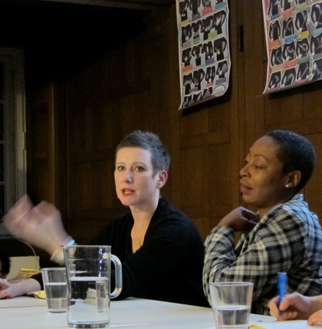
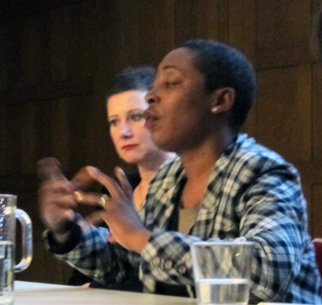
„Artistic Research and Museums“ Collections. Lessons from the Weltkulturen Museum, Frankfurt/Main.Presentation and diskussion with Dr Clémentine Deliss (Weltkulturen Museum Frankfurt/Main) and Otobong Nkanga (Amsterdam). ZMO-Kolloquium 2012/2013. The Impossible Aesthetic: Situating Research in Arts and Social Sciences/Humanities. Zentrum Moderner Orient, 31st of January 2013, Berlin. Photos: Stella Veciana.
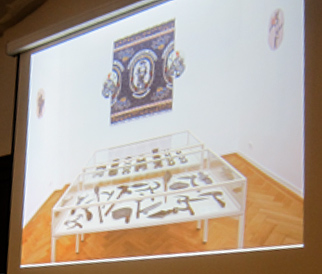
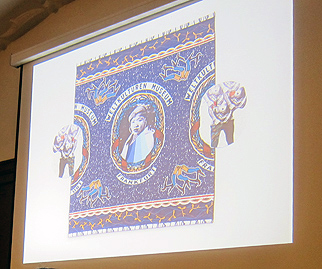
„Memory of Absent Things“, Installation at the exhibition "Object-Atlas", Weltkulturen Museum, Frankfurt/Main, 2012. Fotos: Stella Veciana.
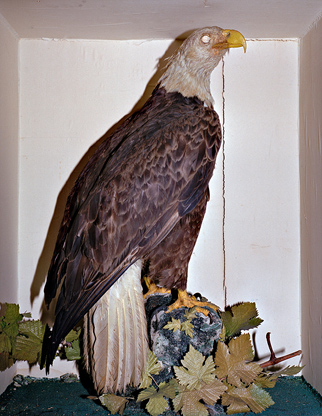
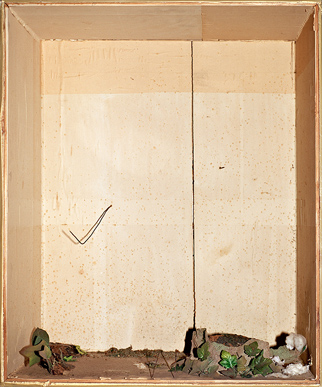
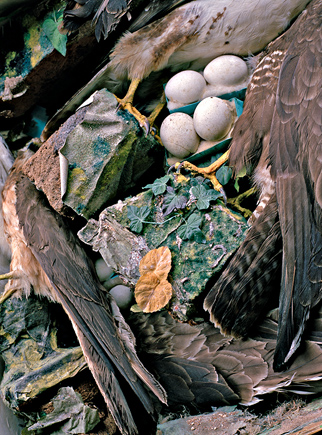

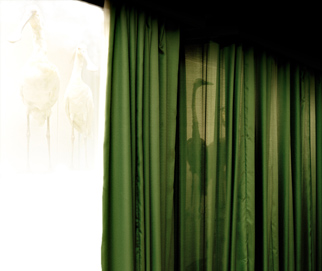
The above five photos belong to an artistic series of photographs - a field work about a permanent collection of historical specimens - by the photographer Richard Schütz, 2003 - 2011.
|
"Re-valuing Archives". Collections of Fieldwork as Seed-beds for the Future”. Stella Veciana in conversation with Richard Schütz.
Collections as laboratories for the future: what would they look like? Collectors as the treasurers of future visions? Usually we think of the collector less as a meticulous detective of the future, and more as the diligent guardian of the past, but whatever our picture of the collector is, one thing is certain; they give their collections of found objects a cultural value. The objects in a collection obtain a particular value determined by us humans: a value of meaning, of enjoyment, or of rarity, which increases their worth. For certain, the constantly changing values of our culture also determine whether artefacts are sorted out of collections or continue to be preserved for future generations.
The objects in collections have long histories before they even enter into a permanent collection. They have probably changed owner and location several times. They were sold, stolen, traded, inherited or given away. In this movement they might get lost, overlooked or forgotten. Maybe it was just a coincidence whether they survived a war or if they were vandalized. Maybe after the clearing out of an apartment, they landed in the storage of a bookshop, or even disappeared in the diffuse zone of the black market. What is ultimately incorporated into the social legacy of a collection depends on many factors. In this article we want to raise the question how we should handle our existing legacy, to keep it alive and present as our collective memory.
In times of rapid biodiversity loss, the collections of natural history museums are given new socially important tasks. Museums of world cultures, on the other hand, are confronted with the open question of how to deal with the disappearance of many indigenous cultures. How can the social function of what used to be a museum of ethnology be renewed? What responsibility do museums have, so that the meaning of formerly known everyday objects don’t get lost on future generations, or so that our children may still learn about species that have gone extinct? How can the appreciation of collections be activated? How can vivid spaces of knowledge be created to encourage the protection of endangered species and cultures? These issues will be addressed within the concept of the “Research Museum”, and by participatory field research. Two good practical examples follow, of how it is possible to transform a piece from a collection, stored in the archive, into a catalyst for future significance: One of them is the exhibition Object Atlas, developed by the museum director Clémentine Deliss (* 1960), introducing an appreciative and cooperative field research method into the museum. The other is the subjective / documentary research and also transformative artistic work of photographer Richard Schütz (* 1965).
The lecture room of the Centre for Modern Oriental Studies[1] is filled by an interested audience. Their attention is focused on Clémentine Deliss, Director of Weltkulturen Museum in Frankfurt am Main, and the in Amsterdam living artist Otobong Nkanga. Deliss starts her presentation by referring to artists of the nineties who have already dealt with the ethnographic method of field research, including Fred Wilson (* 1954). We call to mind the ambiguous title of his exhibition Mining the Museum (1992), which refers to a "blast mine" as a significant find. In this exhibition he created new relationships between objects from the Maryland Historical Society collection. In the showcase Metal Works, 1793-1880, silver goblets are displayed together with - handcuffs made of steel. This makes visible the museum practice of separating the "beautiful" from the "terrible" in exhibitions. Nkanga will also use metal implements such as handcuffs and weapons in her work for the Weltkulturen Museum collection, but more on that later.
Equally impressive, is the artistic practice of Lothar Baumgarten (*1944), who in the late seventies (1978-79) created his own collection. The collection resulted out of Baumgarten living closely together with Yanomami natives of the Amazonian forest for about 18 months. In an interview with Deliss, Baumgarten describes how he came to collect about 1,200 items, 500 drawings and 44 hours of sound recordings: "What had initially started coming together quite unplanned through bartering, was increased by appreciation and affection (...)“.[2] Over time, he got frightened particularly by the fragile transience of their objects, and the cultural loss of the Yanomami by land acquisition and habitat contamination: “The more conscious I became of the destruction of their entire culture, the more alerted and driven I got, trade with them as many objects as seemed meaningful, to save them from inevitable loss." By bartering with them, he had learned how by swapping things, Yanomami gave their objects a specific meaning and context. For example, their arrowheads contain information about their area of origin, their owner, and his status and political alliances. The exchange is a "social exchange of vital importance. It gives them the opportunity to put their knowledge into play, to gain self-affirmation and to increase or defend their social status by a good exchange." However, the museum visitors usually miss the social contexts that determine the meaning of things.
Deliss aims to counteract this loss of context and individuality through a fieldwork practice within the museum. For this, she has set up a laboratory within the Weltkulturen Museum. The Weltkulturen Labor allows artists to live and work in the immediate vicinity of the archive. The collection consists of around 67,000 objects from Oceania, Australia, Southeast Asia, America, Africa and Europe. The invited artists have four weeks to research these "world regions", to focus on some objects and to develop their own works of art. For Deliss, artists work between perception and shape, between appearance and craftsmanship, and are able to envision the contexts of the artefacts in a specific way through their experimental expertise. Through their work, they give the artefacts new contexts and uses, which can be understood as creating a "prototype". They are prototypes for future innovation and can therefore help give answers to the environmental challenges of the 21st century. In return for the residency, the artists donate one of the works they created there, contributing to the "collection of a collection".
Issa Samb (* 1945), a Senegalese artist who participated in the project, describes step by step how one can approach a collection artistically. An artist would try to put the objects in the foreground, to walk through the archive without immediately classifying, to keep his own assumptions in mind, to find the purely aesthetic and human dimensions, to "socialize" artefacts and "re-number" them as prototypes, in order to critically examine the classification systems that are still containing “seeds of racism". "Ethnographic museums have confused culture with civilization and people with objects. All humans have culture. Civilization is an invention“[3]. This approach to a collection differs from the historical scientific approach.
In his book Science in action[4], Bruno Latour describes the historical motivation to create scientific collections. They developed out of the researchers need to "bring home" their findings. Painters like Thomas Cole (Distant View of Niagara Falls) and Frederic Edwin (Church in the Heart of the Andes) followed Humboldt on his travels to America, and brought their picturesquely-documentary studies back to Europe. The key aspect of this approach is the accumulation process, says Latour. If a researcher brings his finds home with him, these can then be examined from a distance. Later, other researchers armed with the knowledge of the earlier artefacts, bring new finds from the following expeditions. This made it possible to exert influence over other cultures without ever having been there. The result of the accumulation of knowledge is an asymmetry between the knowledge of the "foreigners" and the "locals". This has led to the great divide between "us" and "them", rationality and irrationality. While the knowledge of the "natives" was considered local, particular and non-neutral, the scientists claimed to represent a global, rational and disinterested knowledge, that accumulated their knowledge by adding artefacts in the order of a collection. "Scattered knowledge" is put in contrast to "universal knowledge". However, this divide could be overcome by including the "movement of the viewers", their "perspective, orientation, and scale." Artists in the exhibition Object Atlas, such as Samb or Nkanga, seem to experiment with this kind of procedure. Their approach questions the encyclopaedic knowledge and universal claim of many collections.
The Nigerian artist Nkanga (* 1976) has for her work In Memory of Absent Things selected metal objects from the museum collection: weapons, jewellery and currency. They will be placed side by side with the artworks she produced in Lagos and Tilburg. She explains how helpful it was to work close to the laboratory, and to have access to the documentation, simply, "to have everything in one place". Her piece was developed in three phases: In the first she looked at the artefacts, got familiar with them and choose a couple. Unfortunately, the curator was not available to give advice during her stay, and to find the storage location of the artefacts by inventory number turned out to be very difficult. In the second phase, she observed the artefacts and allowed herself to be touched by them. A gut feeling arose while reading about their history. In this way, a diverse knowledge of metallurgy, geography, but also of the changing values and social narratives attached to the artefacts became part of her work. In the third stage, she set the collection objects "in relation" to her own art and developed her work out of this relationship.
For Nkanga, the artistic field research in Weltkulturen Museum was particularly stimulating as it gave her the rare opportunity to be so close to genuine artefacts. The objects were not locked up in glass cases, so she was able to touch and smell them. On the other hand, she made a painful experience in realizing that she barely knew some of the objects made in her own country of birth. Initially, it was difficult for her to establish a relationship to the artefacts. Some questions arose as to "who you are and where you come from", or "who has actually made these objects". It also led her to question her artistic work: should she really make her own artworks, or should she try to find out to whom the objects had belonged, and to bring them back to their country of origin? How could the artefacts be "brought home"?
With these questions as a starting point, Nkanga gradually developed her own relationship to the history of the artefacts. With printed posters, almanacs and woven textiles, she creates a new form of education and mediation work meant to be accessible to everyone. Everyone can read a poster that explains the story of how the objects were used. Everyone can hang a poster. Her point was to make the objects available to Nigerians, not only as a form, but to show the lifestyle associated with them. On the other hand, she would try to give their own history back to the objects, for example, in the form of the memory of the fallen soldiers that had used these weapons. A different approach to the past of the objects could give them a new present and future, because the value of the objects lie in the meaning we ascribe to them. In addition, the objects in the exhibition itself would be re-mapped. The artists would ensure "that the objects move from one thought to another, from one place to another.“[5]
Through the work of artists in the museum, the objects are "on the move": by acquiring a new meaning they change their history and their future. The institution of the museum abandons its former claim of "accumulation of universal knowledge", which had emerged out of the colonial context of expanding trade routes. The museum is transformed into an "idea factory" of artists, curators, museum professionals and the museum director working closely together. The aim is a long-term working process, beyond the nature of an exhibition event. From the "Wunderkammer" to a "workplace", the methods of field research leads in a new direction. Nkanga, for example, experimented with communication practices, changing them to a practice of civic engagement. For Deliss, this provides a way to create "prototypes" for future innovations. We will come back to the nuances of this term further on.
The question remains as to what extent the experience of field research can actually be comprehended by a museum visitor. To what extent can the fieldwork experience and the cooperation of the artists with the museum staff be communicated to the audience? Does the process of re-interpretation of the artefacts become more transparent if artists make their selected reference books available? Does the artistic process become more easily understandable if one reads the museum directors interviews with the artists? The texts definitely give more information, but ultimately, the museum visitors themselves are encouraged to see the artefacts afresh through the new meanings proposed by the artists. However, the direct experience of "rummaging around” in the archives is not accessible to visitors. Could the fieldwork in the museum be designed in a more participatory way?
"Rummaging" through archives is an experience that lies very close to the practice of photographer Richard Schütz. For nine years he has personally followed the decay and revival of the bird collection of a university archive. The collection is a private zoological display collection that shows insects and exotic mammals, but its core is a bird collection partly up to 150 years old. The rooms in which the already neglected collection was stored, was to be converted into classrooms. In the course of extensive refurbishment, the collection was to be reduced or completely dissolved. Since no funding existed to restore or exhibit the collection, the artefacts were offered to other academic institutions. But these on their hand suffered the same lack of space and could only offer them a temporary home. "Many permanent collections are probably exposed to this unacceptable state of affairs, as their historical research value is ignored or only considered as a burden. This has convinced me, firstly, to document the general condition of the collection, and secondly, to take a different artistic look on it.“[6]
Schütz describes his approach to the collection as a process that has changed over the years: As a first step he tried to objectively document and make evident the "status quo” of the collection. Then, he adopted a subjective perspective and “introduced the object to a new interpretative framework". An example of this is a showcase of an eagle with a missing eye. The missing eye objectively constitutes a blemish and devalues the eagle as a scientific object of study. "For me, it makes the eagle more interesting. It gains a metaphorical meaning. It becomes a blind eagle." The former scientific value transforms into a reflection about assigning or depriving meaning. With his photographic view, Schütz makes visible the loss, the void, the frailty.
He dealt accordingly with stuffed animals that were carelessly stacked in boxes, and with an arbitrary accumulation of collection pieces without any classification system. "This treatment really touched me, because once valuable objects were stored, decontextualized and almost destroyed in a hopeless "Noah's Ark" of moving boxes." His expert knowledge in taxidermy[7] helped him assess the neglected state of the collection pieces. However, in his photographs he transforms the impression of chaos into a composition, a still life with eggs. The beauty of the composition which appears at a first glance, only makes "the brutality of how the objects are dealt with " more striking on a closer inspection. The harmonious composition only apparently outweighs "the impression of preservation".
Next Schütz photographed exhibits packed in plastic bags. "Now, the specimens were concealed and deferred to the attic. Hidden in waste bags they were literally expelled from our consciousness. Cutting tiny holes in the plastic bags, I have given them eyes again”, he said with a wink. "Suddenly, the objects seem to look at the viewer, while still remaining hidden." Schütz redefines the objects, turning them into something else, something with a meaning still to be revealed. They are no longer recognizable as what they are expected to be. This is the attempt to liberate the signifier from its meaning. Being unrecognizable establishes a potential. In a figurative sense, his photographs suggest social processes of dissolving order, which can lead to destruction and emptiness, or just to new meanings.
The following step within the process turns the indefinite meaning of the artefacts back to a possible meaning. The artefacts are staged in display cases, in a situation which suggests a possible meaning. This is where "the unseen is revealed as a poetic moment." The outlines of the figures in contrast to the shadowy shapes turn the image into suggestions deliberately kept open. They turn into “Erscheinungen”. As such, they “transform into a third other”, an image as reference object, which tells us about itself, about its origins. The onlooker can add the perception and observation space of his own experience as a further perspective, and complete the suggested meaning himself. "My intention is to communicate each and everything again by reinventing what I see, giving it a different meaning or holding in suspense the one possible meaning. A bird is a bird is a bird... but so nothing can be re-invented. A bird can differ from its concepts and materiality notwithstanding a more diverse context of meaning."
What is intriguing about the history of this collection is not only Schütz’s attempt to give the birds their freedom back, at least symbolically by photographically documenting their shadow life. Triggered by a change in educational policy, now defending the conservation of museum collections as projects of public relations and research, shortly before its imminent death the collection was then mostly preserved. By now, some of the exhibits have been restored for study purposes in dioramas (showcases) and ecologically contextualized. Schütz was commissioned to photograph the birds "in the best light and within the context of their typical habitat." Here, he puts photography at the service of education. The “Präparat“ in its original function as "available reference object" is contrasted to the "no longer available living animal". This representation of native birds is also poignant in the context of biodiversity loss. They are not only reminiscent of creatures that hardly anyone knows any more, since many species are disappearing due to habitat destruction, but also point out the species as 'ecological indicators'.
As with Nkanga, Schütz also sets collection objects "in motion". Their context and meaning change through the pictorial narration of their known history and conceived future . Both artistic approaches question the handling of collections. Again this raises the question of what connects a scientific to a cultural studies approach to collections? Then consequently also the question of what could connect the research and educational mission of the Weltkulturen Museum with the one of a Natural History Museum? Both artists reflect on man-made objects designed to meet specific functions. In the context of the museum, Deliss introduces the notion of the "prototype". Nkanga has in this conceptual context created a prototype for "the memory of absent things", for future use. Regarding the artistic explorations of Schütz, we could therefore speak of the "presence of dissociated contexts".
In any case, the concept of the “prototype” promises an open form and a possible development, in contrast to the closed appearance of a “stereotype”. However, the prototype is associated with methods of mass production, where the "generalized form" of a product is the goal. Schütz does not want to be associated with this context, because his work is “subjective and meta-communicative-oriented”. Although, he also makes use of the scientific models and experimental arrangements, he has different goals and results. He considers a phenomenon as an impulse for contemplation. The creation of meta-communication is what mainly distinguishes art from science and technology. Unlike the function and use of a prototype, the self-image of the artist switches between practical and symbolical value. Communication, however, is also what links art with science, by transforming and conveying the communicative techniques and forms of the world. A communicative form constitutes proposed knowledge. It can stimulate the viewer to compare it with his own knowledge and develop it further; this is what makes it inspiring. Whether prototype or communicative form, both artistic approaches inspire us to appreciate and value collections of objects, but differently by using collections as testing grounds or seed beds for the future.
↑ 1. „Artistic Research and Museums“ Collections. Lessons from the Weltkulturen Museum, Frankfurt/Main
Presentation and discussion with Dr Clémentine Deliss (Weltkulturen Museum Frankfurt/Main) and Otobong Nkanga (Amsterdam). ZMO-Colloquium 2012/2013. The Impossible Aesthetic: Situating Research in Arts and Social Sciences/Humanities. Zentrum Moderner Orient, 31st of January 2013, Berlin. In collaboration with Prof Dr Kerstin Pinther and Prof Dr Tobias Wendl (Freie Universität Berlin).
↑2. All quotations of Baumgarten are taken from: "OBJEKT ATLAS". Catalogue of the exhibition. Edited.: Clémentine Deliss. Bielefeld : Kerber Verlag, 2012, p. 405-6.
↑3. Clémentine Deliss, op. cit. p. 37.
↑4. Bruno Latour. „Science in action.“ Open University Press. Stony Stratford, 1987.
↑5. Clémentine Deliss, op. cit. p. 165.
↑6. All quotations of Schütz are tanken from of a conversation between Richard Schütz and Stella Veciana that took place on the 1st of April 2013.
↑7. Dermoplastic (griechisch derma = skin, plastein = build), Taxidermy (from the Greek for arrangement of skin[1]) is the art of preparing, stuffing, and mounting the skins of animals (especially vertebrates) for display (e.g. as hunting trophies) or for other sources of study. Taxidermy can be done on all vertebrate species of animals, including mammals, birds, fish, reptiles, and amphibians.
comment
|